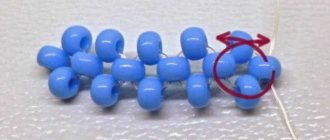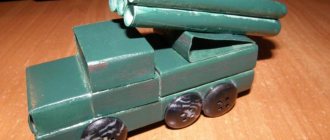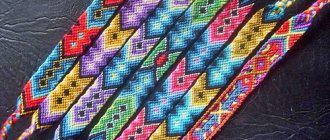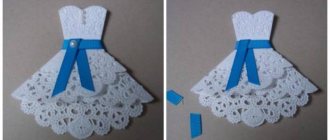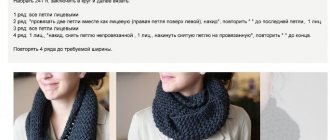Sewing dresses yourself was fashionable until the twentieth century. Then came the era of boutiques, shopping centers, and people forgot about sewing machines. Nowadays you can learn everything at home or in quick courses, so why not try to sew a fashionable dress with your own hands?
In this article we will tell you:
- Styles and styles of dresses
- What is the easiest dress to make for beginners?
- What fabric to choose for the dress?
- How many meters of fabric do you need for a dress?
- How to take measurements correctly?
- How to make a dress pattern: master class for beginners
- Sewing tools
- How to sew a dress: step-by-step master class
Flowy fabric dress
Prepare the fabric. Its size depends on your height and build. Therefore, it is necessary to measure the desired height. It is measured from the armpit to wherever you want (above, below the knee). And the width should be such that you can wrap the fabric 2 times.
The fabric for this product is selected to be light, flowing, it is better that it stretches. You should not use cotton fabric.
Thus, it turns out to quickly sew a dress without a pattern. Finish all edges of the product and, if desired, overlay with a seam. Thin straps are sewn onto 2 corners.
The whole dress is ready, all you have to do is wrap it around it and you can go to the beach.
First, the first strap is put on, then the dress is wrapped around the body and the second strap is put on. If desired, you can add a beautiful belt.
Additional items
Once the style of the future dress has been chosen, you need to think about whether the product will have additional elements in the form of pockets, buttons, ribbons, elastic bands or locks.
Remember that it is not recommended to overload the item with additional elements. Since it is easier to choose accessories, jewelry and shoes for a more laconic dress.
Therefore, buy additional details for the future dress only after finalizing the sketch of the dress.
Knitted dress
Knitwear is perfect for this option. In order to make the top blank, you can use a comfortable loose T-shirt. The skirt is taken to the bottom.
Thus, carefully place the T-shirt on the folded fabric and combine it with the skirt. Make notes. Don't forget to leave 0.5-1 cm for allowances.
Now you need to cut and sweep the blank, sew all the seams (shoulders and sides) and a simple dress without a pattern is ready.
Note!
- Knitted raglan - step-by-step instructions, patterns, recommendations. Photo review of the best works and new products from craftswomen
- Knitting a shawl - step-by-step instructions for making a shawl with your own hands. Tips for beginners on knitting + photo reviews
Amigurumi ring ⭕: features of the amigurumi technique. Step-by-step DIY master class with simple knitting patterns + 180 photos
Ideal workplace
Sewing a dress is easy - if all the working conditions contribute to a productive process. To do this, first of all, you need to organize a comfortable workplace.
A book table can become a universal assistant in the process of sewing a dress. When assembled, the furniture takes up little space, and when disassembled it can accommodate absolutely all work accessories and even a sewing machine.
A sewing chair should be stable and comfortable, preferably with a straight back. A high-quality table lamp with adjustable leg height and tilt is also important for work.
Note!
- Knitted raglan - step-by-step instructions, patterns, recommendations. Photo review of the best works and new products from craftswomen
- Knitting a shawl - step-by-step instructions for making a shawl with your own hands. Tips for beginners on knitting + photo reviews
- Amigurumi ring ⭕: features of the amigurumi technique. Step-by-step DIY master class with simple knitting patterns + 180 photos
The workplace must be equipped with an outlet if you will use a sewing machine or steamer in your work.
Canopy dress
This is the so-called canopy dress. Stretch fabric works great.
The dimensions of the canvas are approximately 130-150 cm.
Fold the fabric four times. Measure your hips. Measure from the side where the fold is 1⁄4 of the measurement and add a couple of centimeters for a loose fit.
Then you need to mark the vertical to a height of 0.5 m. Open the folded fabric and stitch on the resulting segment. The corners should be drawn with a semicircular line.
Excess fabric should be cut off. Mark the neckline 5*30 centimeters. Finish all seams. The dress without a pattern is ready. For summer clothes, light, breathable fabrics are suitable.
Sew it yourself or order it?
Making a dress with your own hands is a reliable way to save yourself from unnecessary expenses on a craftsman, as well as on additional changes that you want to make to the overall appearance of the dress.
When making it yourself, the entire work process will be completely under your control. Despite the complexity and painstaking work, the process can be very exciting.
By making a dress without anyone’s help, you can show all your imagination, as well as express your own individuality.
Sewing a dress for a woman is almost as easy as sewing a dress for a doll. All you have to do is take accurate measurements, use the right material, and be attentive to every stage of the work.
To avoid disappointment in the process of making your own dresses, practice making dresses for mothers, friends or daughters. After all, taking measurements on yourself is more difficult than on another person. Very often, such a seemingly difficult activity becomes a favorite hobby of many girls.
Tunic
This option can be used as a tunic or as a separate item. First you need to decide on the choice of fabric. Fold it in half (right side to right side) and iron it.
Note!
- Knitted braids: simple patterns and the best master class for creating patterns with knitting needles. How to knit braids with your own hands + photo reviews
- Knitting booties for newborns: detailed patterns for knitting booties for beginners + 150 photo reviews of the best products
- Mittens - TOP 100 photos of the best creation ideas. Description of the technique + instructions for knitting mitts with your own hands for beginners
Mark: set aside the length of the product (100 cm), width (1/2 of the hip volume - 27 cm), 1⁄2 of the chest volume (25 cm), length from shoulders to waist (55 cm), neckline (28 cm down) and 11 cm to the left, connect the neckline with a smooth line), shoulder (step back 5 cm from the top edge and draw a shoulder line).
You need to cut out 2 such parts. Sew all seams and finish the neckline. Sew an elastic band or thread a beautiful ribbon onto the waist line.
Styles and styles of dresses
The types of dresses are growing as fashion develops. They are divided by silhouette, waist, top, bottom, skirt and even by season. It’s impossible to list all the styles, so we’ll tell you about the most popular ones:
- direct;
- A-silhouette;
- double-breasted;
- trapezoid;
- flared;
- dress shirt;
- shift;
- tunic.
Dresses with a wrap, loose fit, for example, a straight silhouette, kimono dresses with or without a belt are becoming increasingly popular.
Every year, preference is given to 1-2 styles. 2022 was no exception and also captured 2022.
Fee for plus size ladies
This dress is for plus size people without a pattern; it will help hide all imperfections and highlight beautiful shapes.
For the upper part of the product you will need a piece of 1.5 m, leave 10 cm for the length from the shoulders to the waist. Fold the fabric in half and cut it.
Leave 30 centimeters for the width of the sleeves. Set aside 50 cm from the bottom contour of the product.
The distance between the two sleeves is 1⁄2 the size of the hips + 10-13 centimeters. Finish the sleeves with double stitching and make a drawstring. Make a beautiful satin ribbon.
Finish processing the skirt. Sew and finish all seams. Create beautiful and even folds on the waist line.
Sew two parts of the dress. Sew the hem with a double seam. Overlog all seams.
The dress with a chic floor-length skirt is ready.
How to take measurements
To make a clothing pattern, you need to take measurements in accordance with the characteristics of the person’s figure:
- SSH ─ semi-circumference (s/o) of the neck. Measured at the base of the neck;
- SG ─ sub-breast. The centimeter is placed along the lower part of the shoulder blades and connects at the heights of the mammary glands;
- ST ─ near the waist. A centimeter is placed along the narrow part of the figure;
- SB ─ p/o hips. The centimeter is placed along the high points of the buttocks and connects in the middle of the abdomen. The hip line is located 15-18 cm below the waist;
- LTS ─ length (l) of the back to the waist line. The centimeter is located from the base of the neck parallel to the spine to the waist line;
- DPS ─ the length of the front to the waist line. Measured from the base of the neck, through the height of the chest to the waist line;
- DI ─ for the product. Place the centimeter from the seventh cervical vertebra to a certain length;
- ШС ─ back width. This is the distance between the corners of the left and right armpit;
- ШП ─ front width. The centimeter runs from the right armpit, above the chest and to the left armpit;
- VPr ─ armhole height. Measured from the base of the neck to the corner of the armpit;
- VH ─ bust height. The centimeter runs from the base of the neck to the highest part of the bust;
- DP ─ for the shoulder. The centimeter is located from the base of the neck to the collarbone;
- OP ─ shoulder circumference. The centimeter runs horizontally across the widest part of the upper arm;
- DR ─ for sleeve. The centimeter runs from the shoulder mark to the desired length;
- CG ─ center of the chest. The centimeter runs between the protruding points of the bust.
Measurements for a man Measurements for a woman
Shirt dress
Prepare a shirt (preferably 2-3 sizes larger). A master class on how to make a dress without a pattern will help you update and diversify your wardrobe.
Let's consider as many as 2 options for making simple dresses from an ordinary men's shirt. These options are distinguished by their ease of manufacture.
Doesn't require much effort. No patterns are used. All you need is patience and maximum imagination.
Choose products made from cotton or linen fabric.
In order not to do unnecessary manipulations, it is better to purchase shirts made of dense and non-transparent material.
Dresses can be decorated to suit every taste. For example, sew on beads or rhinestones, or maybe you decide to hang a beautiful new brooch; embroidery elements will also look beautiful.
Basic T-shirt pattern
And here is a pattern for a real basic T-shirt made of thick cotton jersey, with a set-in sleeve. Even complete beginners should not have any difficulties here. Everything is described in great detail in the sewing instructions for the pattern.
Size range from 36 to 60, 4 heights.
First option
- The most suitable fabric option is linen.
- Take waist measurements.
- The neckline of the dress will be V-shaped.
- Determine the highest point of the cutout, where the straps will be located.
- Now you need to find the lowest point. It will define your cleavage.
- If the shirt has a pocket, it should be cut off.
Where to begin:
From the top button on the shirt, measure down to the lowest point of the neckline. Approximately 19 centimeters. Decide on the waist width. To do this, you need to take 1⁄2 of your waist size + 2-3 centimeters. From the waist up, draw 18 centimeters. This is where the armhole will come from.
Measure 11-12 cm from the buttons. The straps will be located here. Connect all the marks together. It begins, an outline emerges. From all marked lines, retreat 1-2 cm to the seams.
Now you need to cut: along the waist line, along all marked lines. Now start processing the back. Draw a line 18 cm from the waist.
Cut along the line, leaving 1-2 cm for seam allowances. You should have 2 pieces for the top. Place them right side together and sew.
Make undercuts. This is done to ensure that the top fits your figure.
Draw a line at the level of the straps. Divide in half. Draw a line. You should get a triangle. The resulting line needs to be stitched. Now all the edges of the top need to be folded 2 times and stitched on a sewing machine.
Now you need to make the straps. They can be made from a sleeve. The width of the strap is approximately 2-3 cm. Fold the edges of the strip towards the center and bend it in half again. Run a line along the edge. Try on the top. And at the highest point of the top, mark the location of the straps and then sew.
All that remains is to sew on the skirt. To begin, unfasten all the buttons. Use a wide seam to sew the entire length. Using one thread, gather the fabric into folds. Distribute evenly over the entire length.
Attach the bottom to the top. First, connect everything using auxiliary pins. Sew two parts. There you go!
How to sew a dress: step-by-step master class
Finally, we come to the most important and interesting thing. The measurements have been taken, the patterns are ready, the tools are on the work table. Let's look at how to sew a dress step by step.
Step one: try on a sour cream dress. This is necessary in order to take into account all the individual aspects of the model’s figure and, in case of inaccuracies, correct them. Step two: sew the shoulder seams. Step three: sew the side seams. They are sewn from the bottom to the point where the sleeve is sewn in. It is located approximately 25 cm below the top corner of the dress (the shoulder seam is located in this corner). Step four: sew the sleeves. Don't forget about the extra centimeters that we left just for the seams. Step five: sew the bottom of the sleeve.
Often instructions alone are not enough, and the help of a mentor is still required. It also happens that a straight dress is already a passed stage, and you want to increase your level of knowledge. There are courses for this where they will show and tell you everything. Under the guidance of an experienced master, you will learn everything and can even make money from sewing!
The ideal intensity of courses is 2 times a week. Everyone chooses for themselves, but this frequency allows you to assimilate the material covered best.
On average, courses cost about 30,000 rubles. There are cheaper and more expensive ones, but you need to check them according to the following criteria:
- Duration of courses. There is no point in taking a year's course to try it out. People prefer to go through everything quickly, so they choose the shortest possible time.
Please note that the items in the courses are sewn to size and not small. This is an important part of learning.
It also happens that courses teach how to sew small things, that is, not in size or doll-sized ones. These are some wrong courses, they make the wrong honey, or rather, clothes. It’s better to give up such activities and find others, so that at the end you can dress not only the kindergarten group, but also your loved one.
Perfect!
- Plenty of practice is required. Theory is good, but you can’t build a house and you can’t sew a dress on it alone. Therefore, please familiarize yourself with the lesson program in advance.
- Additional learning materials to take home. These are either printed notes or video lectures. Writing lectures manually takes a lot of time.
- There should be enough equipment for everyone. It is recommended that it be from the same company and adapted to home sewing machines. Otherwise, you will have to relearn, and this will take up your time.
- Teacher's competence. The course teacher must be a practicing seamstress. And he must speak an understandable language. Terms are beautiful, but their meanings need to be explained simply and clearly.
- Reviews. Read them from independent sources, not on the course website. This increases the chances of finding out the truth.
After completing the courses, the student must receive support from the teacher. The ability to call your mentor at any time and clarify points where difficulties have arisen is an important and enjoyable component of good courses.
Diplomas and certificates don't really matter. When hiring, the first thing they will look at is your portfolio and skills.
1.5–2 years on the market is the period by which you can focus when choosing courses. Those who have just opened need time to get up to speed and understand the situation. Some courses cannot withstand the load and are quickly closed, but those who were able to and remained in business can be trusted.
If your desire to learn how to sew has increased, then quickly sign up for courses and make your dreams come true. Cast aside your fears and try. You can do everything and even more!
This training may be right for you:
- Best Online Cutting and Sewing Courses from 1,100 Rubles
- 10 Best Cutting and Sewing Courses in Moscow
- Best Cutting and Sewing Courses in St. Petersburg
- 10 Best Lingerie Sewing Courses in St. Petersburg from 1,500 rubles
Second option
A vertical striped shirt works well for this option.
From this option we sew a dress without a pattern.
- If there are grooves on the back, they should be cut out.
- Iron the shirt.
- Cut out the area of fabric up to the sleeves.
- Remove the pocket, it will get in our way.
- Remove the sleeves for now, but they will still be needed.
Let's get started:
Fold one part of the shirt in half and draw a line 12 cm long. From this line, draw down 25 cm. Draw a straight line.
Draw a diagonal line from the armpit area to the bottom edge of the product.
Place a 7 cm mark for the armpit opening. Connect 2 dots together. Cut with seam allowances of 2-3 cm.
Now you should start processing the back. Place the 2 pieces right sides together and stitch where the line with the buttons is. Fold the piece in half. Find the mark for the armhole and at this point fold the first piece and draw a line to the second. Cut out.
Place the pieces right sides together and sew along the sides using a sewing machine and fold in all open edges. Now let's start making the straps. They are cut from the sleeve.
The straps are made according to the same principle as in option 1. Sew on front and back.
You can sew ruffles along the hem line. The dress turned out to be summery and very comfortable.
How to make a dress pattern: master class for beginners
There are two options for the development of events:
- the product is designed, that is, about 15 measurements are taken;
- There are ready-made patterns in the magazine, for which you only need to measure the circumference of the chest, waist and hips.
Our experts Marina Khmel and Ekaterina Putrova explained how the process of creating a pattern occurs:
If a product is being designed, then the same 15 measurements are found from the table, and then, following the formula, choosing a certain technique, the product is rebuilt.
In the second case, a suitable size is found from the plate, the pattern is transferred to tracing paper, and thus a pattern is obtained. The pattern is transferred to the fabric, and the resulting pieces are swept away.
To baste is to make a hand stitch without a sewing machine.
So, the pattern instructions are just for you!
Stage one:
Stage two:
Stage three:
Ready! You are gorgeous!
Dress with a scarf
For this style, you need to take two scarves measuring 1.5 * 1.5 m. During the work, you will need additional elements for decoration. This cut of a dress without a pattern is suitable for girls with curvy figures.
Stages of work:
The two were made to be connected with the front side, to distribute the correct arrangement of the pattern. Baste the seams, departing 20 centimeters from the front edge, measure 23 cm from the back side. Sew all parts and iron them.
Using a pencil, mark the line of the back. Use tape to trim the free edge.
The straps are sewn to the edge at chest level and cross at the back. An elastic band is sewn under the bust.
The dress is ready, you can put it on and go for a walk around the beautiful evening city.
Why sew a dress yourself
It’s not just the meager and monotonous choice that pushes girls to decide to make their own outfit. Several reasons may influence the decision:
- inappropriate size range: some girls have a non-standard figure, for which it is difficult to choose an outfit that exactly fits in size. Too miniature parameters or, on the contrary, “lush” shapes interfere with the choice of outfit in the store;
- price: an unusual dress of good quality always costs a lot of money;
- allergy to material: often it is an allergic reaction to natural or synthetic fabrics that forces you to abandon your dream dress.
Shift dress
This product uses a loose sleeveless dress pattern. It takes a little time and effort to make. Does not require skills to build or model a product.
Prepare:
- Textile;
- Car;
- Sewing supplies.
Progress:
Before you begin, you need to take measurements:
- Product length (di);
- Length to waist (lt);
- Chest circumference (g);
- Hip circumference (about).
- Cut two rectangles for the future product; they must correspond to the width (about) size.
- For length add 4 cm.
- It is very important that the grain thread runs along the length of the product.
- Fold the fabric right sides in half.
- To prevent the fabric from creasing while drawing lines, you can pin it with auxiliary pins.
- Measure from the left side DT+2 cm.
- Draw a line to waist level.
- From the same point, draw a segment equal to 1/4OB + 2 cm.
- Mark the shoulder line and connect them using a pattern.
- Draw a line to the waist using a pattern.
- You should end up with 2 identical parts, front and back.
- Mark the rollout size. This is done at will.
- Along the bottom border of the product, mark a line equal to 1/4OB.
- Prepare a ribbon for the belt. 8*75 cm.
- Fold all the blanks in half. Seal the edges with a double stitch. The stitching should extend 0.5 mm from the edge.
- Iron all parts.
- Fold the pieces inside out, sew all seams (shoulder and side) and press the seams with an iron.
- Decorate the neckline by folding the fabric in 2 layers.
- Make decorative seams throughout the product, departing 1-1.5 cm from the main seam, thereby stitching the ends of the fold.
- At waist level, sew on parts of the belt
- Finish the bottom edge of the dress.
- Iron the product.
- Can be decorated with decorative elements.
The dress turns out to be light, you can wear it at home as a robe or go to the beach in it.
Materials and tools
To work you will need a standard set:
- sewing machine;
- threads;
- needle;
- scissors;
- ruler;
- tape measure;
- chalk or soap;
- paper or tracing paper;
- pins.
You can use your old T-shirt instead of a pattern. Then you won't need paper at all.
If desired, you can use additional accessories: ribbons, buttons, bows, rhinestones, laces. It is also worth considering how the cut areas will be processed. You can overlock them, trim them with braid, piping or bias tape.
Photos of dresses without patterns
Robe
Calico can make a charming robe. We fit an oval into a rectangle 135 by 145 cm. We retreat 80 cm from its edge and measure 22 cm in both directions from this point. Now from these points you need to lay two perpendiculars 20 cm long. We will cut these two lines, as they will serve as armholes.
We process and bend the armholes. All we need to do is sew on a belt or ribbon, and the robe is ready.
You can sew clothes for newborns with your own hands from chintz. Baby vests, light blouses, caps for your beloved child. A dowry for a baby, a dress for a daughter, a robe for yourself - all this is quick, hassle-free and inexpensive, made from natural lightweight material.
